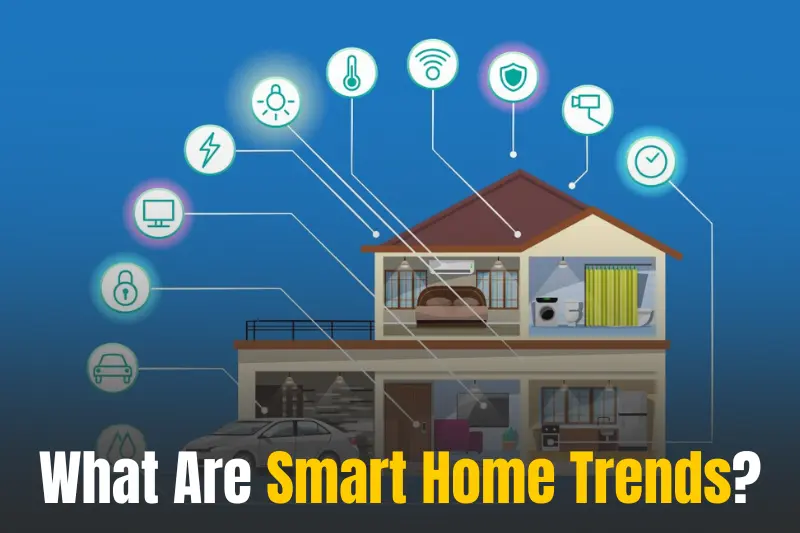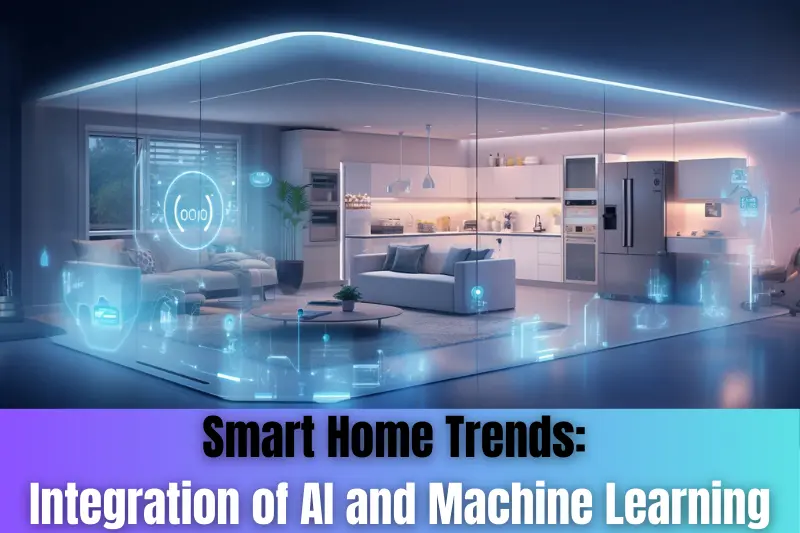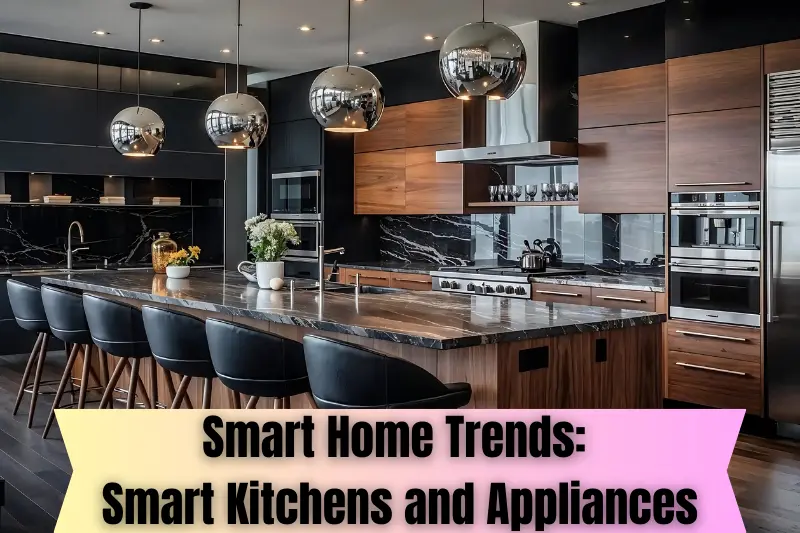Smart home technology is changing the way we live, making our homes more convenient, secure, and energy-efficient. From controlling lights with your voice to monitoring your home from anywhere, smart home trends are constantly evolving.
As more people embrace these innovations, it’s important to stay updated on the latest smart home trends that can make your life easier and more comfortable. In this article, we’ll explore the most exciting trends that are shaping the future of smart homes.
What Are Smart Home Trends?

Smart home trends refer to the latest innovations and advancements in technology that make homes more connected and automated. These trends focus on integrating smart devices and systems that improve the convenience, security, and energy efficiency of a home.
- Voice Control Integration: More devices are being controlled using voice assistants like Alexa, Google Assistant, and Siri.
- Energy Efficiency: Smart thermostats, lighting, and appliances help homeowners save energy and reduce utility bills.
- Enhanced Security: Smart cameras, doorbell systems, and locks offer improved home security and remote monitoring.
- Automation: Devices are becoming more intelligent and can learn your habits, adjusting settings automatically.
- Connectivity: The Internet of Things (IoT) allows multiple devices to connect and work together seamlessly, creating a smart ecosystem.
Why Are Smart Home Trends Important for Homeowners?
- Convenience: Smart home trends allow homeowners to control various devices and systems easily from their phones or by voice, adding convenience to daily tasks.
- Security: Smart security systems provide peace of mind with real-time alerts, surveillance, and remote control, helping protect homes and loved ones.
- Energy Savings: With energy-efficient smart devices, homeowners can reduce energy consumption and save on utility costs.
- Increased Property Value: Smart home features can increase the market value of a home, making it more attractive to potential buyers.
- Improved Quality of Life: Smart homes make everyday tasks easier and more enjoyable, creating a better living environment for all family members.
You may also like it:
Personal Finance Guide: Tips for Financial Success
Tech Startup Tips: Key Steps to Launch Successfully
Easy Budgeting Tips: Manage Your Money Smartly
Smart Home Trends: The Rise of Voice Control
Voice control is one of the most popular trends in smart homes today. Voice assistants like Alexa, Google Assistant, and Siri are transforming the way we interact with our homes. These devices allow homeowners to control various aspects of their home with simple voice commands, making everyday tasks easier and more efficient.
- Hands-Free Convenience: Voice assistants eliminate the need for physical interaction with devices. You can control lights, thermostats, music, and more, just by speaking.
- Smart Home Integration: Voice assistants can control multiple smart devices, like lights, locks, cameras, and even appliances, all from one central hub.
- Daily Routine Assistance: You can ask your voice assistant to provide daily updates like weather forecasts, traffic reports, or reminders, making your routine more organized.
Real-life Example: How Voice Control is Used in Everyday Life
- Voice-Controlled Lighting: Imagine you’re cooking dinner and your hands are full. Instead of getting up to turn off the lights, you can simply say, “Alexa, turn off the kitchen light,” and it happens instantly.
- Smart Thermostats: On a hot summer day, instead of adjusting the temperature manually, you can say, “Hey Google, set the temperature to 72 degrees,” and your thermostat will do it for you.
- Entertainment Control: You can easily play music, podcasts, or control your TV by asking your voice assistant, like, “Alexa, play my workout playlist” or “Google, turn on Netflix.”
- Home Security: When leaving the house, you can say, “Alexa, lock the front door,” ensuring your home is secure without having to check manually.
Smart Home Trends: Energy Efficiency and Sustainability
As concerns about the environment and rising utility costs grow, energy-efficient appliances and systems are becoming a significant part of smart home trends. These innovations help homeowners reduce their energy consumption, lower utility bills, and contribute to a more sustainable future.
- Smart Thermostats: Devices like Nest or Ecobee learn your heating and cooling preferences over time and adjust temperatures automatically to save energy when you’re away or asleep. They can also be controlled remotely, allowing you to adjust the temperature before you arrive home.
- Smart Lighting: LED bulbs with smart features can be programmed to turn off when not in use, adjust brightness based on time of day, or be controlled remotely via smartphone or voice assistants. Smart bulbs like Philips Hue also allow homeowners to create lighting schedules, reducing energy waste.
- Energy Management Systems: These systems monitor and control energy usage in a home. Devices like Sense and EnergyHub track energy consumption in real-time, helping homeowners identify which appliances are using the most energy and make adjustments to improve efficiency.
- Smart Plugs and Outlets: With smart plugs, you can schedule when devices like coffee makers, TVs, or fans turn on or off, preventing energy waste by ensuring devices aren’t left running when not needed.
- Solar Panel Integration: Many smart homes are now integrating solar panels with energy management systems to optimize energy production and consumption. Homeowners can track solar energy production and usage in real-time, maximizing their reliance on clean energy.
Smart Home Trends: Integration of AI and Machine Learning

Artificial Intelligence (AI) and Machine Learning (ML) are revolutionizing smart homes by making them more adaptive and personalized. These technologies enable devices to learn from user behavior, predict needs, and automate tasks, creating a truly intelligent home environment.
- Learning User Habits: AI-powered systems track daily routines, learning when you wake up, go to bed, or leave the house. This information helps devices anticipate your needs and adjust settings automatically, such as controlling the thermostat or lights based on your preferences.
- Predictive Automation: Smart home devices using AI can predict what you need before you even ask. For example, a smart thermostat can learn your ideal temperature settings and adjust the heat or air conditioning when you’re likely to be home or awake.
- Personalized Recommendations: AI can analyze data from your usage patterns and suggest energy-saving settings or new ways to optimize your home. For instance, a smart refrigerator might suggest recipes based on the ingredients you have, or recommend grocery items you often buy.
- Adaptive Voice Assistants: AI-driven voice assistants like Alexa or Google Assistant learn the way you speak, your preferred commands, and your habits over time. This allows them to respond more accurately and efficiently, becoming more useful the longer you use them.
- Smart Security Systems: AI enhances home security by learning and recognizing familiar faces, distinguishing between family members and strangers. For example, Ring or Nest Cam IQ cameras use AI to send alerts only when unfamiliar faces are detected, reducing unnecessary notifications.
Real-life Example: AI-driven Systems that Predict User Needs
- Smart Thermostat: An AI-powered thermostat like Nest learns when you’re typically at home or away and adjusts the temperature to ensure comfort while saving energy. It might automatically turn off the heat or air conditioning when you leave, and begin warming or cooling your home just before you arrive.
- Smart Lighting: AI-enabled lighting systems can detect when you’re in a room and adjust brightness or even color based on the time of day or your previous preferences. For example, the lights might automatically dim in the evening to create a cozy atmosphere without you needing to adjust anything.
- AI-driven Home Assistants: If you regularly ask your voice assistant to play music during a workout, the system can learn to suggest specific playlists or podcasts without needing to be prompted.
Smart Home Trends: Enhanced Home Security
Smart home security devices are evolving rapidly, offering homeowners increased protection, convenience, and control. From cameras to smart locks, these devices provide real-time monitoring and the ability to manage security from anywhere, making home security more efficient and reliable than ever.
- Smart Cameras: Modern smart cameras, like Ring or Nest Cam, offer high-definition video, night vision, and motion detection. Many cameras now feature two-way audio, so homeowners can speak to visitors or intruders through the camera, adding an extra layer of security.
- Smart Locks: Smart locks like August and Schlage allow homeowners to lock and unlock doors remotely using a smartphone app. They can also provide temporary access codes for guests or service workers, giving you more control over who enters your home.
- Connected Security Systems: Full smart security systems, such as SimpliSafe or ADT, combine cameras, sensors, motion detectors, and alarms into one integrated system that can be monitored remotely. These systems often include professional monitoring services for extra peace of mind.
- Smart Doorbells: Devices like the Ring Video Doorbell allow homeowners to see and talk to visitors at the door through their smartphones, even when they are not home. These devices send alerts when motion is detected, providing an extra layer of surveillance for front and back doors.
- AI and Facial Recognition: Many smart security cameras now feature AI and facial recognition technology, allowing them to distinguish between familiar faces and strangers. This helps reduce false alerts and ensures that only unfamiliar visitors trigger notifications.
- Smart Sensors: Sensors on windows, doors, and even garages can alert homeowners when a door or window is opened. These sensors work in tandem with other security devices, such as cameras or alarms, to provide a more comprehensive security system.
- Remote Monitoring and Control: Through mobile apps, homeowners can monitor their property in real-time from anywhere. Whether you’re on vacation or at work, you can check live video feeds, lock doors, or adjust security settings from your phone.
- Integration with Other Smart Devices: Many smart security devices now work in tandem with other smart home devices. For example, smart lights can be programmed to turn on if motion is detected, or security cameras can sync with smart speakers for added alerts.
With these advancements, smart home security is becoming more intelligent, offering more features and better protection than traditional systems. Homeowners now have the ability to monitor, control, and secure their homes more effectively than ever before.
Smart Home Trends: The Internet of Things (IoT) in Homes
The Internet of Things (IoT) is transforming how devices communicate with one another within a home. By connecting various smart devices through the internet, IoT enables seamless interaction between appliances, lighting, security systems, and more. This connectivity makes everyday tasks more efficient, convenient, and automated.
- Connecting Devices for Convenience: IoT allows smart devices to communicate with each other. For example, your thermostat can adjust the temperature when you unlock your smart door, or your security cameras can send alerts to your smartphone when motion is detected.
- Smart Refrigerators: Modern smart refrigerators are equipped with IoT technology to help streamline grocery management and food storage. These fridges can track the items inside, suggest recipes based on what you have, and even alert you when you’re running low on essentials.
- Smart Speakers and Home Assistants: IoT-enabled smart speakers like Amazon Echo or Google Nest act as the central hubs for controlling other smart devices. By simply using voice commands, you can control lights, thermostats, or even order groceries, all from a single device.
- Integrated Home Automation: IoT enables devices like lights, thermostats, and entertainment systems to work together. For example, you can set your lights to turn on when you arrive home, and your thermostat can automatically adjust to your preferred temperature before you even step inside.
- Health Monitoring: IoT devices in the health and wellness category, such as smart scales, sleep trackers, and air purifiers, can sync with one another and with your smartphone. They provide real-time health data, which can be used to improve daily habits and well-being.
- Smart Cooking Appliances: IoT-connected kitchen appliances like smart ovens or slow cookers allow you to control cooking from a distance. You can preheat the oven remotely, receive alerts when your food is ready, or even adjust cooking settings from your smartphone while you’re away.
- Smart Lighting Systems: IoT lighting systems can be scheduled or adjusted to match your daily routines. For example, lights may turn on automatically when you wake up or gradually dim in the evening to prepare you for sleep, based on your preferences.
- Home Energy Management: IoT helps monitor and manage energy consumption across devices. Smart plugs and energy meters track power usage and provide insights, allowing homeowners to identify areas where they can save energy, like turning off unused devices or adjusting settings for efficiency.
- Remote Control of Home Devices: With IoT, you can control virtually any smart device from anywhere using your smartphone or voice. Whether you’re adjusting the thermostat, turning off lights, or checking security cameras, IoT provides total control at your fingertips.
Example: How Smart Refrigerators or Smart Speakers Are Integrated into Daily Routines
- Smart Refrigerator: Imagine your fridge notifying you that your milk is almost out. It can send a reminder to your phone or even place an automatic order through an online grocery service. It can also help plan meals by suggesting recipes based on the ingredients inside.
- Smart Speaker: A smart speaker like Amazon Echo or Google Home acts as a voice-controlled hub, enabling you to set reminders, check weather forecasts, control lights, play music, or even adjust the thermostat while you go about your day—making life easier and more connected.
Smart Home Trends: Smart Kitchens and Appliances

The smart kitchen is rapidly becoming a central feature of modern homes, transforming the way we cook, store food, and manage our kitchens. Smart appliances like ovens, refrigerators, and coffee makers are not only making tasks more efficient but also improving the quality of life by adding convenience and automation to the kitchen.
- Smart Ovens: These ovens allow users to control cooking settings remotely through apps or voice commands. Features include preheating the oven, setting timers, and even adjusting temperatures—all from your smartphone or voice assistant.
- Smart Refrigerators: These fridges come with features like internal cameras, which allow you to view the contents from your smartphone. They can also track expiration dates, suggest recipes, and send reminders when you’re running low on key ingredients.
- Smart Coffee Makers: With smart coffee makers, you can schedule when to brew your coffee or control brewing strength remotely. You can even customize your coffee preferences through an app for the perfect cup every time.
- Smart Dishwashers: These appliances have advanced sensors to optimize water usage and energy efficiency. They can also be controlled remotely, allowing users to start or pause cycles from their phone.
- Smart Slow Cookers and Pressure Cookers: Devices like Instant Pot or Crock-Pot are now equipped with smart features, allowing users to adjust cooking times, set delays, or monitor progress from their smartphone, even while away from home.
- Smart Kitchen Scales: These scales can connect to apps to track nutritional information, provide recipe suggestions, and ensure precise measurements for your cooking, helping you follow your recipes to the letter.
- Smart Cooktops: Cooktops with smart technology offer features like temperature control via smartphone apps or built-in sensors that automatically adjust cooking heat based on what’s in the pan.
Example: How Smart Appliances Help with Cooking or Food Storage
- Smart Oven: Imagine you are at work, and you want to have dinner ready when you get home. You can use your smartphone to preheat the oven while you’re still on your way back, so your meal cooks as soon as you walk in the door.
- Smart Refrigerator: A smart fridge can notify you when you’re running low on milk, vegetables, or any essential items. It can even create a shopping list for you or automatically reorder your groceries through integrated services, ensuring you never run out of important ingredients.
- Smart Coffee Maker: With a smart coffee maker, you can set it to brew your coffee at exactly the right time each morning, so it’s ready when you wake up. You can also adjust the strength, temperature, and type of brew to match your preferences for the day.
Smart Home Trends: Health and Wellness Features
Smart home technology isn’t just about convenience and entertainment—it’s also increasingly focused on improving health and wellness. Devices like air purifiers, sleep trackers, and fitness monitors are helping homeowners maintain better health by providing real-time insights and creating healthier living environments.
- Smart Air Purifiers: These devices automatically detect pollutants and allergens in the air, adjusting their settings to clean the air efficiently. Many models, like Dyson Pure Cool or Honeywell HPA300, can be controlled remotely and offer real-time air quality data through apps.
- Sleep Trackers: Devices like the Fitbit Charge or Withings Sleep monitor your sleep patterns, providing insights into sleep quality, duration, and even heart rate variability. These devices can suggest ways to improve your sleep, such as adjusting your sleep environment or changing your bedtime routine.
- Smart Humidifiers: Smart humidifiers like the Levoit Smart Humidifier can automatically adjust humidity levels to optimize comfort and respiratory health. They often come with app control, allowing users to set schedules and monitor indoor air quality.
- Smart Thermometers: Devices like the Kinsa Smart Thermometer allow users to monitor body temperature and track health data over time. These thermometers can send alerts and provide advice based on symptoms, making them useful for keeping track of health trends in real-time.
- Fitness and Activity Monitors: Wearable devices such as Apple Watch or Garmin track daily physical activity, monitor heart rate, and provide insights on how to stay active and healthy. These devices help you set fitness goals and provide feedback on your performance.
- Smart Water Bottles: Devices like HidrateSpark track your hydration levels and remind you to drink water throughout the day. These smart bottles sync with apps to ensure you stay on top of your daily water intake goals.
- Air Quality Monitors: Devices that measure pollutants, allergens, and CO2 levels, such as the Awair Element or IQAir AirVisual, help ensure that the air you breathe indoors is clean and safe. They can alert you to changes in air quality and suggest actions to improve it, such as opening windows or activating an air purifier.
Example: How Air Quality Monitors Can Improve Health at Home
- Air Quality Monitoring: A smart air quality monitor like the Awair Element tracks levels of pollutants such as dust, pollen, and VOCs (volatile organic compounds) in your home. When the air quality drops, the device can send a notification to your phone, prompting you to activate your air purifier or take other actions to improve the environment.
- Better Breathing: By regularly monitoring the air quality, you can make sure that your home remains free of harmful allergens and pollutants, which can reduce respiratory issues, asthma flare-ups, and other health problems related to poor air quality.
- Health Alerts: If the monitor detects dangerous levels of CO2 or allergens, it can notify you to take immediate action, such as opening windows or using a fan, to restore a healthy atmosphere.
Smart Home Trends: Smart Lighting Solutions
Smart lighting is one of the most versatile and customizable aspects of a smart home. With advancements in smart bulbs, dimmers, and controls, homeowners can now adjust their lighting to suit their lifestyle, save energy, and create the perfect ambiance for any situation.
- Color-Changing Bulbs: Smart bulbs like Philips Hue or LIFX allow users to change the color and brightness of their lights. These bulbs can be adjusted to fit different moods, events, or times of day, giving you complete control over your home’s atmosphere.
- Smart Dimmers: With smart dimmers, you can adjust the brightness of your lights without needing a physical dimmer switch. These dimmers can be controlled remotely via smartphone apps or voice assistants, allowing you to set the perfect lighting for any occasion.
- Voice-Controlled Lighting: Integration with voice assistants like Alexa, Google Assistant, or Siri makes it possible to control your lights using just your voice. You can say commands like, “Alexa, dim the living room lights,” or “Google, turn on the kitchen lights,” for hands-free convenience.
- Automated Lighting Schedules: Smart lighting systems allow you to set schedules for your lights, so they turn on or off at specific times, whether you’re at home or away. For example, your porch light can automatically turn on at sunset and turn off at sunrise, saving energy and adding convenience.
- Motion-Sensor Lighting: Smart lights equipped with motion sensors can automatically turn on when you enter a room and turn off when you leave, making them energy-efficient and convenient. This is especially useful in areas like hallways, bathrooms, and garages.
- Integration with Other Smart Devices: Smart lighting can integrate with other smart home systems, such as smart thermostats and security systems. For example, if your security system detects motion, it can trigger lights to flash, alerting you to potential intruders.
- Energy-Efficient LED Bulbs: Many smart bulbs use energy-efficient LED technology, which reduces electricity usage and lowers utility bills. You can also monitor energy consumption through connected apps and make adjustments to optimize your home’s energy use.
Example: How Smart Lighting Can Adjust Based on Time of Day or Mood
- Morning: In the morning, smart lighting systems can gradually brighten your lights to mimic a natural sunrise, helping to wake you up gently and start your day energized. You can program your lights to slowly increase in brightness over a set period of time.
- Evening: As the day winds down, smart lighting can automatically adjust to a warm, dimmed light to help you relax and unwind. For example, your living room lights can change to a soft amber color to create a cozy atmosphere for reading or watching TV.
- Mood Settings: For entertainment or hosting guests, smart lighting can instantly change the colors and brightness of your bulbs to match the mood. You can select from preset themes, such as a party mode with vibrant colors or a calming setting with cooler, dimmer lights for a peaceful ambiance.
Smart Home Trends: The Future of Smart Homes
The future of smart homes looks incredibly promising, with cutting-edge technologies like 5G connectivity, advanced automation, and augmented reality (AR) transforming the way we interact with our living spaces. These innovations will further enhance the convenience, efficiency, and functionality of smart homes, making them even more intelligent and intuitive.
- 5G Connectivity: With the rollout of 5G, smart homes will experience faster, more reliable internet connections. This will enable seamless communication between devices, reduce latency, and improve the performance of smart appliances, security systems, and entertainment devices.
- Advanced Automation: The future of automation in smart homes will involve more complex systems that learn from user behaviors and preferences. Homes will become more self-sufficient, automatically adjusting temperature, lighting, security, and entertainment based on real-time data, user habits, and even predictive algorithms.
- AI-Powered Personal Assistants: AI will continue to evolve, providing more sophisticated voice assistants that can understand and predict your needs. These assistants will be capable of controlling every aspect of your home, from adjusting your environment to scheduling tasks without any input from the user.
- Smart Home Robots: In the future, robots will play a key role in smart homes. These robots will assist with tasks like cleaning, cooking, and even elderly care. Smart vacuums, delivery robots, and robots capable of assisting with household chores will become more common and capable of working autonomously.
- Augmented Reality (AR): AR will allow homeowners to interact with their smart devices in entirely new ways. Through AR glasses or screens, users could visualize the status of different systems in their homes (lighting, security cameras, etc.) or even receive real-time instructions and guidance for home repairs and maintenance.
- Biometric Home Systems: Future smart homes may use biometric security features like facial recognition or fingerprint scanning to provide more secure and personalized access to the home. This could replace traditional keys and passwords with more advanced, secure methods of entry.
- Smart Materials and Surfaces: In the future, we may see smart materials integrated into the very structure of the home. Walls, windows, and even furniture could adjust their properties in response to environmental changes, such as automatically blocking out sunlight or controlling temperature based on weather conditions.
- Sustainability and Green Tech: Future smart homes will be even more energy-efficient, incorporating solar power, smart grids, and sustainable building materials. Homes will be able to monitor and optimize energy use in real time, making it easier for homeowners to reduce their carbon footprint and live more sustainably.
Impact of Augmented Reality (AR) in Smart Homes
- Enhanced Interaction: AR can transform the way homeowners interact with their devices. For example, by using AR glasses or mobile apps, you could overlay information directly onto the real world, such as seeing the status of your smart security system or adjusting your smart thermostat by simply looking at it.
- Smart Maintenance: AR could provide real-time troubleshooting and maintenance instructions for home appliances. Imagine pointing your phone at a smart appliance, and the AR system displays step-by-step guides or video tutorials for any needed repairs.
- Immersive Entertainment: AR will revolutionize entertainment by creating immersive experiences at home. You could project a 3D movie scene onto your living room walls or interact with virtual objects in your home using AR.
Conclusion
The future of smart homes is full of exciting possibilities. With advancements in 5G connectivity, automation, and augmented reality, our homes will become more efficient, connected, and personalized. From faster devices and smarter security to immersive entertainment and energy-saving technologies, the way we live in our homes will continue to evolve.
As these technologies grow, they’ll make everyday life easier, more comfortable, and more sustainable. The smart homes of tomorrow are truly something to look forward to!
FAQs: Smart Home Trends
What are smart home trends?
Smart home trends refer to the latest innovations in technology that make homes more connected, efficient, and automated. These include things like smart lights, thermostats, security cameras, and voice-controlled assistants that help manage everyday tasks.
How do smart home devices help with energy efficiency?
Smart home devices, like smart thermostats and lighting systems, can automatically adjust to save energy. For example, smart thermostats can learn your schedule and adjust the temperature when you’re not home, helping to reduce energy usage and lower bills.
What is the role of AI in smart homes?
AI helps smart home devices learn from your habits and adjust accordingly. For example, a smart thermostat can learn your preferred temperature and automatically adjust it, while a smart assistant like Alexa can help manage your daily tasks and control other devices.
How will 5G improve smart homes?
5G connectivity will provide faster, more reliable internet connections, allowing smart devices to communicate seamlessly with each other. This will make devices more responsive and enable even more complex and efficient automation in homes.
What is augmented reality (AR) and how will it be used in smart homes?
Augmented reality (AR) will allow you to interact with smart home devices in new ways. For example, you could use AR glasses to see the status of your devices or get real-time instructions for home repairs, making it easier to manage your smart home.
Can smart homes improve security?
Yes! Smart security systems like cameras, smart locks, and motion sensors provide better security by allowing you to monitor and control your home from anywhere. Many systems also send real-time alerts if they detect unusual activity.
Will smart homes help with health and wellness?
Absolutely! Smart devices like air purifiers, sleep trackers, and fitness monitors can help improve your health by ensuring clean air, monitoring your sleep patterns, and keeping track of your activity levels.
What are the benefits of smart lighting?
Smart lighting allows you to control your lights remotely, change colors, set schedules, and save energy. You can adjust the lighting to match your mood or time of day, creating a more comfortable and efficient home.
You may also like it:
Saving Money Tips for Students: Master Your Finances Now!
Startup Marketing Strategies: Boost Your Business Fast







